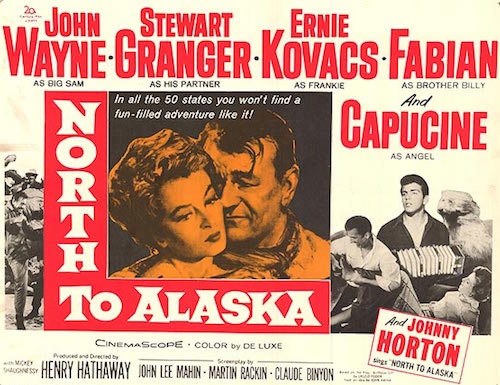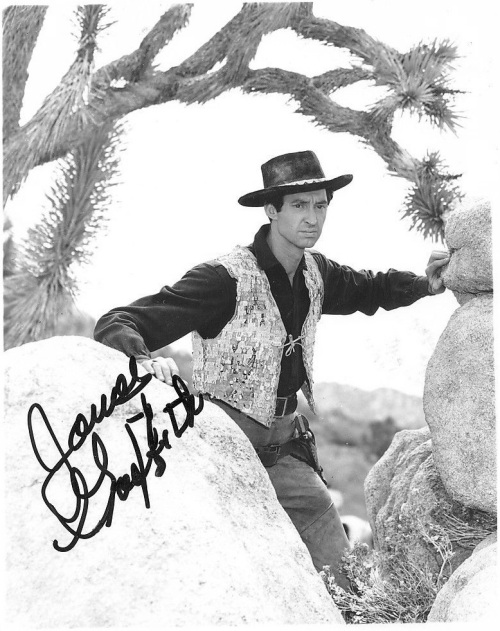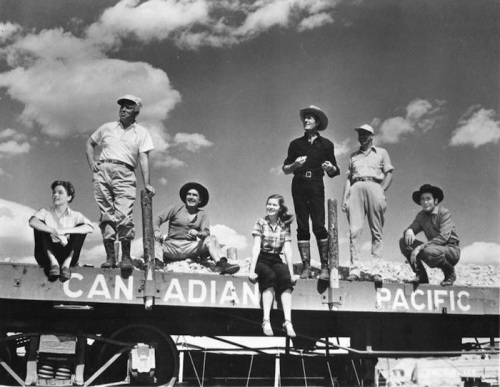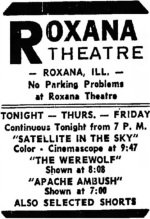Directed by William Castle
Produced by Sam Katzman
Screen Play by Robert E. Kent
Director Of Photography: Lester H. White
Film Editor: Viola Lawrence
Cast: Brett King (Joe Branch), Barbara Lawrence (Kate Manning), James Griffith (Bob Dalton), Bill Phipps (Bill Dalton), John Cliff (Grat Dalton), Rory Mallinson (Bob Ford), William Tannen (Emmett Dalton), Richard Garland (Gilkie), Nelson Leigh (Father Kerrigan)
__________
So glad to see The Fastest Guns Of The West: The William Castle Western Collection turn up in my mailbox. Couldn’t wait to crack it open and give it a whirl. You get Klondike Kate (1943), Conquest Of Cochise (1953), Jesse James Vs. The Daltons (1953), Masterson Of Kansas (1954), Battle Of Rogue River (1954), The Gun That Won The West (1955), Duel On The Mississippi (1955) and Uranium Boom (1956). All directed by William Castle. Most produced by Sam Katzman. And all eight for less than $15.
Jesse James Vs. The Daltons is about as historically accurate as Blazing Saddles (1974) is. Joe Branch (Brett King) might be the son of Jesse James. He and Kate Manning (Barbara Lawrence) — he saves her from a being lynched — hook up with the Dalton Gang to retrieve some loot and locate Jesse, alive or dead.
It’s silly, fast-paced and loads of fun. The picture runs just over an hour, with Castle and DP Lester H. White throwing coffee pots, bullets and dying bad guys at the 3-D camera whenever possible. There’s plenty of ridin’, fightin’ and shootin’, though you can tell the schedule kept the action from getting the staging it needed. It’s a bit sloppy at times.
This might have been Brett King’s only lead, and it was certainly his last feature. He’d do nothing but TV for the rest of his career. After a couple episodes of The Green Hornet in 1967, King and his wife moved to Harbour Island, Bahamas, and opened the Coral Sands Hotel. He became a mover and shaker in the tourism industry down there.
Barbara Lawrence has a decent part here, though there seemed to have been no effort to make her even slightly resemble a woman from the late 19th century. You see that a lot in 50s Westerns. She looks good in jeans, and I guess that was more important (King just happens to have a pair that fits her in his saddlebag). Barbara’s career wasn’t a long one — she gave up movies for real estate — though she’s in some good stuff, including the cool Regalscope sci-fi picture Kronos (1957).
James H. Griffith plays one of the Daltons. He’s always worth watching, and even though he gets third billing, his part isn’t all that big in this one. Castle would give him bigger, better parts in his next two Westerns: Masterson Of Kansas (1954, included in this set) and The Law Vs. Billy The Kid (1954).
Jesse James Vs. The Daltons was shot in Technicolor and 3-D, and it was to be projected at 1.85. It appears here 2-D, of course, and full frame. The picture looks quite good, but as you can imagine, there’s a lot of dead space at the top and bottom of the frame. The zoom feature on my TV took care of some of that. (Mill Creek licenses these pictures from Columbia and works with what the studio sends them.)
The rest of the set looks even better. The real jewel is the black and white Uranium Boom (1956), which looks gorgeous. You’d almost think you were looking at a Blu-Ray. The Fastest Guns Of The West: The William Castle Western Collection is a terrific set, something many of us have been hoping for. As I see it, William Castle could do no wrong, and these movies are good, cheap fun — thanks to Mill Creek for giving us such a budget-friendly, storage-space friendly package. Highly, highly recommended.
To the fine folks at Mill Creek: while you’re serving up William Castle, how about a set of the Whistler movies?



















 Case in point: 1950’s Indian Territory. Autry’s a Confederate veteran serving with the U.S. cavalry now that the war’s over. He’s been sent to get to the bottom of Indian attacks on settlers — and ends up tangling with The Apache Kid (James H. Griffith) and an Austrian gunrunner (Philip Van Zandt). With the help of sidekick Shadrach Jones (Pat Buttram) and the daughter of a local rancher (Gail Davis), Gene restores order to Apache Springs.
Case in point: 1950’s Indian Territory. Autry’s a Confederate veteran serving with the U.S. cavalry now that the war’s over. He’s been sent to get to the bottom of Indian attacks on settlers — and ends up tangling with The Apache Kid (James H. Griffith) and an Austrian gunrunner (Philip Van Zandt). With the help of sidekick Shadrach Jones (Pat Buttram) and the daughter of a local rancher (Gail Davis), Gene restores order to Apache Springs.




 Directed by Edwin L. Marin
Directed by Edwin L. Marin




